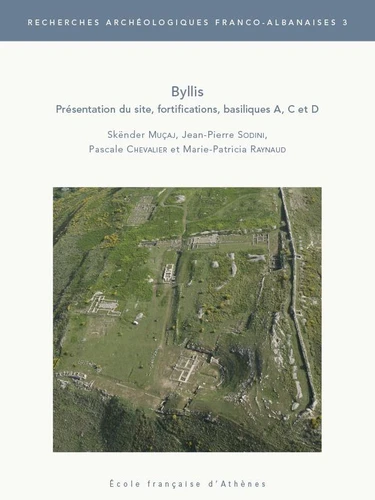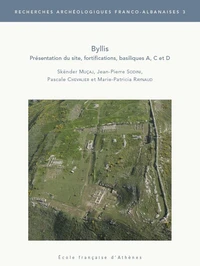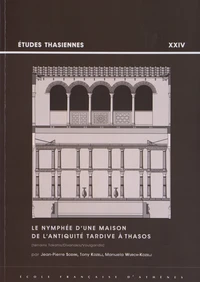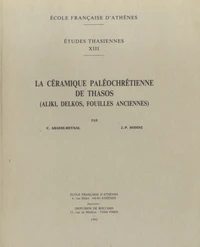- Accueil /
- Jean-Pierre Sodini
Jean-Pierre Sodini

Dernière sortie
Byllis
De 1999 à 2012, une équipe franco-albanaise a réuni, sous l'égide du ministère français des Affaires étrangères, de l'Ecole française d'Athènes et de l'Institut archéologique de Tirana, des spécialistes de l'époque protobyzantine autour de Skënder Muçaj, qui avait mené les fouilles archéologiques sur la ville tardo-antique de Byllis dans les années 1980. Ce premier volume sur le site se propose d'étudier une partie des structures de l'Antiquité tardive mises au jour dans cette cité épiscopale de l'intérieur de l'Epire nouvelle : le mur d'enceinte de la ville remanié sous le règne de l'empereur Justinien, et trois parmi cinq églises paléochrétiennes connues, les basiliques A, C et D.
Outre le rempart et l'architecture de ces édifices de culte, la sculpture, les aménagements et le mobilier liturgique, la décoration des sols et les objets recueillis, offrent une richesse et une variété exceptionnelles, qui font de cet ensemble encore méconnu un jalon urbain essentiel du Sud-Ouest des Balkans. From 1999 to 2012, a Franco-Albanian team was brought together, under the aegis of the French Ministery of Foreign Affairs, the French School at Athens and the Archaeological Institute of Tirana.
They were specialists of the Protobyzantine period around Skënder Muçaj, who had carried out archaeological excavations at the late-antique city of Byllis in the 1980s. The first volume on the site presents a study of part of the structures of Late Antiquity unearthed in this episcopal city in the interior of Epirus Nova : the city wall, altered during the reign of Emperor Justinian, and three of the five known early Christian churches, basilicas A, C and D.
Besides the rampart and the architecture of these cult buildings, the sculpture, layouts, liturgical furniture, decoration of the floors and the collected objects offer an exceptionally rich and varied assemblage, still overlooked, which is an essential urban landmark in the southwest of the Balkans.
Outre le rempart et l'architecture de ces édifices de culte, la sculpture, les aménagements et le mobilier liturgique, la décoration des sols et les objets recueillis, offrent une richesse et une variété exceptionnelles, qui font de cet ensemble encore méconnu un jalon urbain essentiel du Sud-Ouest des Balkans. From 1999 to 2012, a Franco-Albanian team was brought together, under the aegis of the French Ministery of Foreign Affairs, the French School at Athens and the Archaeological Institute of Tirana.
They were specialists of the Protobyzantine period around Skënder Muçaj, who had carried out archaeological excavations at the late-antique city of Byllis in the 1980s. The first volume on the site presents a study of part of the structures of Late Antiquity unearthed in this episcopal city in the interior of Epirus Nova : the city wall, altered during the reign of Emperor Justinian, and three of the five known early Christian churches, basilicas A, C and D.
Besides the rampart and the architecture of these cult buildings, the sculpture, layouts, liturgical furniture, decoration of the floors and the collected objects offer an exceptionally rich and varied assemblage, still overlooked, which is an essential urban landmark in the southwest of the Balkans.
De 1999 à 2012, une équipe franco-albanaise a réuni, sous l'égide du ministère français des Affaires étrangères, de l'Ecole française d'Athènes et de l'Institut archéologique de Tirana, des spécialistes de l'époque protobyzantine autour de Skënder Muçaj, qui avait mené les fouilles archéologiques sur la ville tardo-antique de Byllis dans les années 1980. Ce premier volume sur le site se propose d'étudier une partie des structures de l'Antiquité tardive mises au jour dans cette cité épiscopale de l'intérieur de l'Epire nouvelle : le mur d'enceinte de la ville remanié sous le règne de l'empereur Justinien, et trois parmi cinq églises paléochrétiennes connues, les basiliques A, C et D.
Outre le rempart et l'architecture de ces édifices de culte, la sculpture, les aménagements et le mobilier liturgique, la décoration des sols et les objets recueillis, offrent une richesse et une variété exceptionnelles, qui font de cet ensemble encore méconnu un jalon urbain essentiel du Sud-Ouest des Balkans. From 1999 to 2012, a Franco-Albanian team was brought together, under the aegis of the French Ministery of Foreign Affairs, the French School at Athens and the Archaeological Institute of Tirana.
They were specialists of the Protobyzantine period around Skënder Muçaj, who had carried out archaeological excavations at the late-antique city of Byllis in the 1980s. The first volume on the site presents a study of part of the structures of Late Antiquity unearthed in this episcopal city in the interior of Epirus Nova : the city wall, altered during the reign of Emperor Justinian, and three of the five known early Christian churches, basilicas A, C and D.
Besides the rampart and the architecture of these cult buildings, the sculpture, layouts, liturgical furniture, decoration of the floors and the collected objects offer an exceptionally rich and varied assemblage, still overlooked, which is an essential urban landmark in the southwest of the Balkans.
Outre le rempart et l'architecture de ces édifices de culte, la sculpture, les aménagements et le mobilier liturgique, la décoration des sols et les objets recueillis, offrent une richesse et une variété exceptionnelles, qui font de cet ensemble encore méconnu un jalon urbain essentiel du Sud-Ouest des Balkans. From 1999 to 2012, a Franco-Albanian team was brought together, under the aegis of the French Ministery of Foreign Affairs, the French School at Athens and the Archaeological Institute of Tirana.
They were specialists of the Protobyzantine period around Skënder Muçaj, who had carried out archaeological excavations at the late-antique city of Byllis in the 1980s. The first volume on the site presents a study of part of the structures of Late Antiquity unearthed in this episcopal city in the interior of Epirus Nova : the city wall, altered during the reign of Emperor Justinian, and three of the five known early Christian churches, basilicas A, C and D.
Besides the rampart and the architecture of these cult buildings, the sculpture, layouts, liturgical furniture, decoration of the floors and the collected objects offer an exceptionally rich and varied assemblage, still overlooked, which is an essential urban landmark in the southwest of the Balkans.
Les livres de Jean-Pierre Sodini

21,00 €

Byllis. Présentation du site, fortifications, basiliques A, C et D
Skënder Muçaj, Jean-Pierre Sodini, Pascale Chevalier, Marie-Patricia Raynaud
Grand Format
116,60 €

Constantinople réelle et imaginaire. Autour de l'oeuvre de Gilbert Dagron
Cécile Morrisson, Jean-Pierre Sodini
Grand Format
85,50 €

Le nymphée d'une maison de l'Antiquité tardive à Thasos (terrains Tokatlis/Divinakis/Voulgaridis)
Jean-Pierre Sodini, Tony Kozelj, Manuela Wurch-Kozelj
Grand Format
76,32 €

Le Proche-Orient de Justinien aux Abbassides. Peuplement et dynamiques spatiales
Antoine Borrut, Muriel Debié, Arietta Papaconstantinou, Dominique Piéri, Jean-Pierre Sodini
91,00 €

40,28 €

Déhès (Syrie du nord). Campagnes I-III (1976-1978) : Recherches sur l'habitat rural
Jean-Pierre Sodini, Georges Tate, Jean-Luc Biscop, Dominique Orssaud
84,00 €

Les villages dans l'Empire byzantin (IVe-XVe siècle)
Jacques Lefort, Cécile Morrisson, Jean-Pierre Sodini
44,70 €
